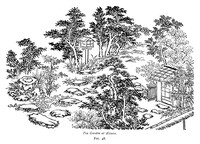The prevailing notion of a pathway leading to the different buildings is kept up alike in the inner and outer garden, the skeleton of the whole design being formed by the stepping stones, which make a meandering route connecting the Water Basin, Waiting Shed, Lavatory, and Gateway with the Tea Room. The areas surrounding these foot-ways consist of beaten earth, purposely kept damp and moss-grown. The different clumps of trees, bushes, plants, and grasses are often arranged in an unkempt manner so as to impart a wild and gloomy effect to the garden. A characteristic example of the style is shown in Fig. 48, illustrating a Tea Garden at Kitano designed by Kanamori Sowa. Most Tea Gardens are remarkable for extreme simplicity combined with an affectation of natural wildness. They may be said to assume an air of respectable poverty and decay, accompanied by the most punctilious cleanliness. In the wooden and stone lanterns, water basins, rocks, and gateways, an appearance of antiquity is sought. The surrounding fences, though often of quaint and pleasing design, are of the flimsiest and most delicate description�like the tiny buildings they enclose, which are specially devoted to the exercise of a ceremonial meant for the cultivation of simplicity and gentleness of manners. Some masters of the Tea cult consider fences undesirable enclosures for Tea Gardens, because of their artificial character, and prefer high banks covered with leafy vegetation, or thick hedges, either of which produce a more natural effect.

